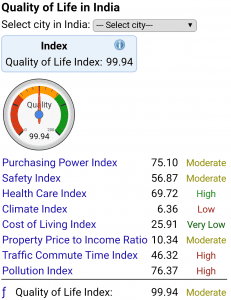Reading Time: 5 minutes
A good growth trajectory includes not just greater growth numbers but a good ‘quality of life’ index for its citizens, too. The big question is, are there more jobs in the offing? Our Associate Editor, Navodita, discusses inequality, disparities in regions, smart cities and much more, hoping that 2018 would be a story of ‘development’, in the weekly column. A Different Truths exclusive.
The government has been going gaga about its achievements and the upsurge in economic activity in their term so far; despite reasonable GDP growth last fiscal. They proudly claim there have been giant strides in terms of implementation of economic reforms and ease of doing business. Moreover, the services sector has also done very well. But what do these growth stories mean for a more ‘equitable distribution’ of wealth in a government tenure that also proclaims ‘social and economic equality’? Does India have the answer?
Going back into history, the 1990s witnessed a disturbing relative increase in suicides by desperate small farmers, suffering from over-indebtedness and diminishing economic opportunities. Impoverished  peasants demonstrated against compulsory land acquisition for industrial factories and real estate development with increasing frequency. The most serious backlash was the renewal of violent Maoist insurgency, which affected 170 out of 602 districts across the country by 2006. The establishment of red bases and liberation zones reflected as much a reaction against the absence of essential public services and productive market activities as the extraction of minerals and commodities in the tribal-dominated hinterlands.
peasants demonstrated against compulsory land acquisition for industrial factories and real estate development with increasing frequency. The most serious backlash was the renewal of violent Maoist insurgency, which affected 170 out of 602 districts across the country by 2006. The establishment of red bases and liberation zones reflected as much a reaction against the absence of essential public services and productive market activities as the extraction of minerals and commodities in the tribal-dominated hinterlands.
The fragmentation of power in India’s ‘third electoral system’ raised many hopes that a progressive ‘third force’ might emerge – the socialist Janata Dal and communist Left Front, two pillars of the broader Indian Left, constituted its core. Although the prospect of a stable Third Front never materialised, the agendas remained very valid, alive and ticking. Its rise at least drew attention to the fact that there is still lot left to be done in the realm of financial inclusion. MGNREGA is one such step forward – it raises the bar of what ‘a socially produced sense of what is necessary to lead a decent life of some worth and self-respect’ requires. Some such acts like Right to Information Act (2005) and Right of Children to Free and Compulsory Education Act (2009) seem to be positive ways forward but to what extent have they managed financial inclusion and guaranteed services that befits a ‘welfare state’.
In a study by Ramphul Ohlan, a researcher based in Haryana, there continue to be disparities in socio-economic development at the district level and within and different regions of India, too. Inclusive development, as envisioned in economic planning in India, incorporates the vital objective of reduction of inter-state, intra-regional and inter-section disparities. It is generally believed that socio-economic indicators should be measured on the basis of a large number of attributes as is relevant and feasible. Ohlan finds out many such indicators most of which are concerned with development in the agricultural sector. His study shows that India’s southern region has been highly and symmetrically developed in comparison to central and northern regions. International comparison of the pattern of development brings out that India’s socio-economic development is far below Ghana, while much above that of Malaysia. The level of development in infrastructure sector was found to be positive. The results show that in northern and central regions of India the level of industrial development does not significantly influence the agricultural and overall socio-economic development. For bringing about uniform regional development, model districts have been identified and potential targets for various development indicators have been estimated for low developed districts. The researcher goes on to suggest that job opportunities should be created in backward districts, too, for the balanced rural upliftment of the people. Efforts are needed for the availability of proper medical facilities and urbanization. If the government wants an equitable distribution of development facilities, attention should be focused on the districts whose development has lagged far behind that of model districts. This will require concerted efforts on the part of state governments and the centre.
Ohlan finds out many such indicators most of which are concerned with development in the agricultural sector. His study shows that India’s southern region has been highly and symmetrically developed in comparison to central and northern regions. International comparison of the pattern of development brings out that India’s socio-economic development is far below Ghana, while much above that of Malaysia. The level of development in infrastructure sector was found to be positive. The results show that in northern and central regions of India the level of industrial development does not significantly influence the agricultural and overall socio-economic development. For bringing about uniform regional development, model districts have been identified and potential targets for various development indicators have been estimated for low developed districts. The researcher goes on to suggest that job opportunities should be created in backward districts, too, for the balanced rural upliftment of the people. Efforts are needed for the availability of proper medical facilities and urbanization. If the government wants an equitable distribution of development facilities, attention should be focused on the districts whose development has lagged far behind that of model districts. This will require concerted efforts on the part of state governments and the centre.
 While the mission of the current government for urban renewal seems to take shape in the form of its ‘Smart Cities Mission’, what remains to be seen is how far and to what extent will it be successfully implemented. While the investment has been meticulous and in large amounts, not much progress has been seen in reality. The mission focuses on developing a small area of a city with latest amenities and replacing them pan-city later. There have already been discrepancies- there is underutilization of funds for one.
While the mission of the current government for urban renewal seems to take shape in the form of its ‘Smart Cities Mission’, what remains to be seen is how far and to what extent will it be successfully implemented. While the investment has been meticulous and in large amounts, not much progress has been seen in reality. The mission focuses on developing a small area of a city with latest amenities and replacing them pan-city later. There have already been discrepancies- there is underutilization of funds for one.
According to a Business Today report, Urban Affairs Ministry revealed that only 7% of the funds for the cities has been released for the states, which is not completely used. Often it is found that funds being released may not even be reaching the people at large. In fact several smart cities lik e Bhopal, Indore, and Pune, for example, still face problems of water shortage, power cuts, bad roads and underdeveloped public areas. The mission is not truly successful as it needs to link up with other missions like Open Defecation-free campaign among others.
e Bhopal, Indore, and Pune, for example, still face problems of water shortage, power cuts, bad roads and underdeveloped public areas. The mission is not truly successful as it needs to link up with other missions like Open Defecation-free campaign among others.
While the central government might have launched some very good missions, campaigns, and policies to make ‘fruits of development’ reach out to a large population, a lot needs to be done. A good growth trajectory includes not just greater growth numbers but a good ‘quality of life’ index for its citizens, too. The big question is – are there more jobs in the offing? 2018 needs to be a story of ‘development’ and to go by what author and global investor, Ruchir Sharma says, not necessarily, good economics should be good politics once again in the coming year. On the contrary, states with good growth rates may just see an anti-incumbency factor at play. Will the government have ‘development for development’s sake’ or just target the electorate with false promises, the coming year will answer.
©Navodita Pande
Photos from the Internet
#QualityOfLifeIndex #FalsePromises #SmartCitiesMission #SocioEconomicDevelopement #IndianEconomy #GovernentAndEconomy #CommonPeople #GDP #FiscalGrowth #Aamonomics #DifferentTruths

















It is true that growth should reflect in human development and government effectiveness indicators.